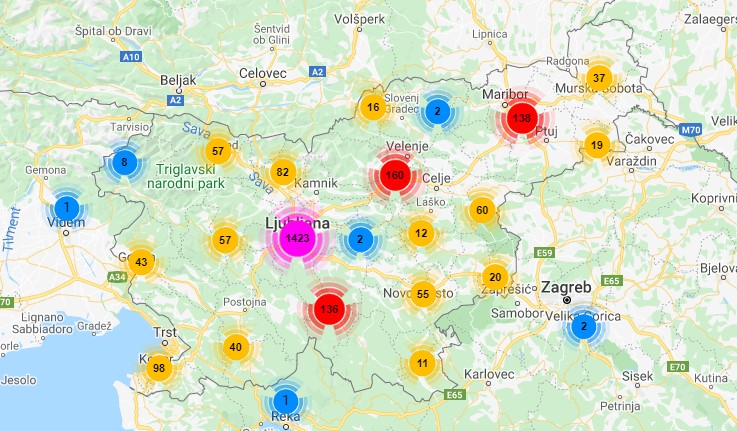WORK FROM HOME IN THE COVID-19 EPIDEMIC (second survey, February 2021)
At the Faculty of Civil and Geodetic Engineering, University of Ljubljana, we research the implementation of work from home during the COVID-19 epidemic (location, scope, adequacy of working conditions). The survey was conducted for the first time in spring 2020. It covered the first wave of the epidemic and it was conducted only in Slovenia. Now we are extending it to other countries.
We kindly ask you to fill out the survey questionnaire in the language that suits you best (EN, FR, DE, IT, ES, HR) and help us with our research. It takes about 5 minutes to complete the questionnaire. We would also appreciate if you could share the survey through your business and personal channels.
An English summary of the first survey synthesis results can be found below.
WORK FROM HOME IN THE FIRST WAVE OF THE COVID-19 EPIDEMIC
(spring 2020, summary of results on working conditions from home)
Assist. Prof. Dr. Gregor Čok; Sen. Lect. Dr. Mojca Foški; Assist. Dr. Gašper Mrak; Assist. Prof. Dr. Alma Z. Lamovšek
During the 1st wave of the coronavirus epidemic Chair of Spatial Planning from Faculty of Civil and Geodetic Engineering, University of Ljubljana, created a questionnaire with which we wanted to evaluate conditions for work from home (WFH). From March 13, 2020, WFH was mandated to most employees in Slovenia, according to the restrictions implemented with the declaration of the epidemic. The questionnaire was distributed primarily via e-mail addresses of the employees of the University of Ljubljana, which is also reflected in the results of the survey.
The survey questionnaire was opened by 2031 respondents, of whom 1895 filed out the questionnaire in full. The questionnaire was filed out by 1263 women and 632 men (Figure 1). As many as 89% of the respondents have at least a university degree, with a predominance of age groups 27-44 years (45%) and 45-64 years (41%). In terms of work status, the majority are employed (86.2%) (Figure 2), of these mostly in tertiary (17.8%) and quaternary (76.7%) sectors of the economy (Figure 3). By field of work, employees in education (78.3%) and public administration (16.3%) predominated. We are aware that the results also depend to some extent on the way the survey was distributed, which means that we may not have reached other employees in the tertiary sector who also worked from home.
Figure 1: Percentage of respondents by gender
- Female 67%
- Male 33%
n = 1895
Figure 2: Employment status of respondents
- Employee 86,2%
- Student 8,2%
- Self-employed 2,5%
- Other 3,1%
n = 1895
n = 1681
Respondents live primarily in single-family homes (41.8%), two-apartment buildings (18.5%), or an apartment in a multi-family residential (37.9%). During the epidemic, as many as 84.2% (1595) of the respondents worked from home because they were forced to do so, 2.3% were already working at home where they have a registered business, and 8.4% continued to work at their usual place of employment with their employer.
81.1% (Figure 4) of respondents who practiced WFH did more than 85% of their monthly work responsibilities from home (54.7% responded that they did all of their work from home). 40.5% of respondents reported that they also work from home when there is no epidemic.
- 81 – 100 81,1%
- 61 – 80 9,0%
- 41 – 60 7,2%
- 21 – 40 1,8%
- 0 – 20 1,0%
n = 1595
Figure 5: The room where the respondents performed work from home
- study or cabinet 39,9%
- living room 29,8%
- kitchen/dining room 27,4%
- bedroom 21,7%
- children’s room 6,8%
- other 1,9%
n = 1595
Respondents performed WFH in the study (39.9%), living room (29.8%), kitchen or dining room (27.4%), bedroom (21.7%) and children’s room (6.8%). 1.9% of respondents mentioned other rooms, listing the hallway between bedrooms, the basement, the gym, the social room, the garage, and even the garden and balcony (Figure 5).
The results also show that for most respondents, the working conditions for WFH were relatively good (Figure 6), as the average score of all respondents regarding the adequacy of working from home was 7.4. Considering the unpredictability of the situation, the score is surprisingly good as people could not prepare for working from home in advance. On the other hand, we can note that the educational and professional structure of most respondents suggests faster responsiveness and flexibility, as well as sufficient information and communication technology equipment and adequate living conditions.
Figure 6: Overall assessment of the adequacy of work from home
n = 1681
Residents in multi-apartment buildings in particular reported missing having an extra room in their home (33.7%), having their own lawn (19.2%) and having a garden to grow vegetables (15.5%). Surprisingly, however, almost half of them (45.6%) did not miss any of the things mentioned (Figure 7).
A fairly large percentage of respondents (7.9%) chose the answer “other” but did not mention space issues in their responses. They focused more on the need for better information and communication technology (although one of the survey questions also addressed this), and even more on the lack of social contacts, childcare assistance, ending mobility restrictions, etc.
Figure 7: Spaces that respondents missed while working from home (multiple answers possible).
- an additional room 33,7%
- own lawn 19,2%
- own garden for growing vegetables 15,5%
- larger rooms 14,6%
- own yard 13,2%
- terrace 11,5%
- green areas near home (eg. park, forest) 8,8%
- balcony 7,0%
- none of the above 45,6%
- other 7,9%
n = 1895
Spatially, the responses were spread all over Slovenia – some responses even came from neighboring countries (Figure 8). Nevertheless, larger cities (Ljubljana, Maribor and Celje) were in the lead in terms of the number of responses.
Figure 8: Map of the spatial distribution of the respondents

In the survey sent out in the second wave of the COVID19 epidemic, we expanded the questionnaire to include the student population. We also expanded the scope of addressees in order to reach the part of the working population that is not employed in public administration or education and also works from home.
The research is financially supported by the Slovenian Research Agency within the research program P2-0227 Geoinformation Infrastructure and Sustainable Spatial Development of Slovenia.






